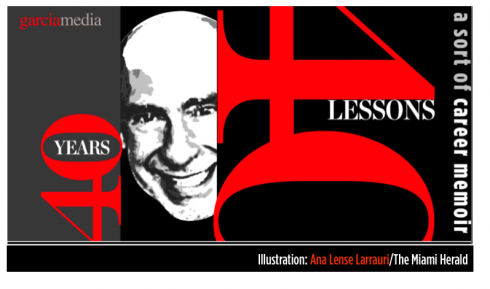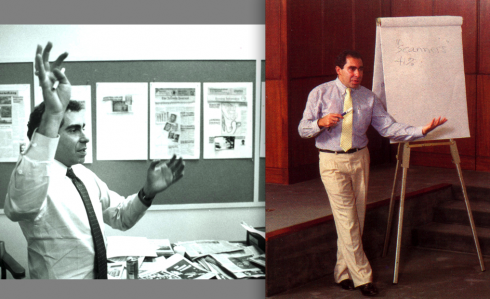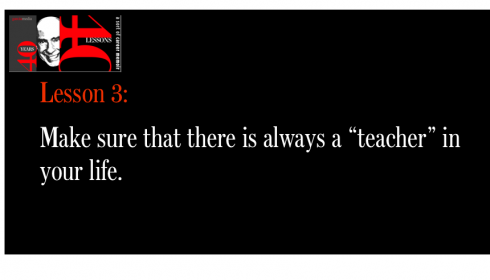TAKEAWAY:This is part 3 of my occasional series 40 Years/40 Lessons, which I call a “sort of career memoir” capturing highlights and reminiscing about what has been a spectacular journey for me, doing what I love most. Today’s segment: Teaching is my favorite part of the job.
Call me teacher


It is unmistakeable. When I pass through immigration or customs anywhere in the world and they ask me what I do, almost without thinking, I usually say: I am a teacher.
It is what comes natural. No, I don’t have an academic appointment at the moment, although I give lectures and special classes at various institutions during the year, including The Poynter Institute for Media Studies, a dear place to me.
Teaching, however, is what I do everyday. The newsroom is a classroom. The lunch hour becomes a mini seminar. The after dinner conversation just before the launch of a project is almost like a final exam review. Remember those?
I must say that this is one of the most fascinating aspects of my job, whatever description one gives it. There is a Chinese proverb that tells us that “Teachers open the door. You enter by yourself. “
I’d like to think that I have been opening those doors for two generations of the best students anyone can ever hope for.
It all started in 1970 when my son Mario Jr. was barely four months old. It signaled the start of my career.
Miami-Dade Junior College, North Campus, needed someone to replace the legendary Barbara Garfunkel, one of my dearest mentors (you will read all about her in the Mentor segment of 40Years/40Lessons) , my former journalism professor, and the grand dame of journalism education in Miami for almost 50 years. Miss G was transferring to Miami-Dade’s South Campus, the newly open campus in the area of town closer to her home.
Not that anybody could truly replaced Miss G, as we all affectionately called her.
Introducing Mr. G
I tried, becoming Mr. G to a legion of students who were barely five years younger than me when I first took up the job of adviser to the award-winning Falcon Times—-the student newspaper—-of which I had been editor in 1967. The job involved teaching two journalism classes in basic reporting.
As adviser to a student newspaper you become parent substitute, shrink, father confessor and mentor. I relished the roles, all of them, and still have the fondest memories of those days, and the satisfaction of seeing so many of my Miami-Dade students who have gone on to extremely successful media careers. Several still write me, and anytime I see a Dear Mr. G in the salutation, I know this is one of my Falcon Times kids. Oh, yes, no matter how old they may be, to me they are always “my kids”.
By 1974, when Miss G decided to retire for good, I again followed in her footsteps, moving to the South Campus to advise the also award winning Catalyst, the weekly campus newspaper.
The student newspaper
Nothing can match the experience one gets working in a student publication, and I treasure my experience both as a student editor of The Oracle, at the University of South Florida, the Falcon Times, and, then, of course, returning as the adviser.
My years as teacher/adviser taught me much. There is hardly any difference between the river of human emotions that runs thru a student newsroom and what I discovered later in professional environments. You have the hard workers who are never satisfied with what they do and aim for more; you have the super talented who lack the drive to achieve (few of them usually go anywhere); you have the less talented who set goals and follow them (they win Oscars and Pulitzers and live in the mansion of stability), and you have the insecure, the competitive and the one who should have never entered the room but somehow managed to pass thru the screening.
The main difference I found between a student newsroom and a professional one: the students know they are there to learn and are not afraid to let you guide them by the hand; some professionals tend to see asking for help as a mark of incompetence or lack of knowledge.
I have learned that professionals who don’t let go of the “student” within them will have a more successful career, always learning, forever adding new ways of doing things they have done for a long time. Sort of like the adults not totally abandoning the child in them.
Along comes the opportunity of a lifetime
In 1976, I had a call from my good friend C. Marshall Matlock, of Syracuse University, asking me if I wanted to apply for a position to teach graphic arts at the S. I. Newhouse School of Public Communications.
The icon of newspaper design, Professor Edmund Arnold, was about to retire (not that he did so completely, as he stayed with academics at Virginia Commonwealth University).
Am I supposed to replace legends?, I asked myself.
On the other side of the equation was the idea of leaving warm Florida, with its palm trees swaying outside my Miami-Dade South office, Cuban Miami, our family. Maria had already lived in Columbus, Ohio, as a teenager and knew all about winters. I didn’t, and she was not emphatic enough in her arguments about snow, ice and driving in the mess.
With four small children in tow (just picture what the budget was—-in a professor’s salary—- to get all of them attired with hats, coats, mittens and snow boots), we decided to move to upstate New York.
Now, I would be teaching exclusively visual journalism——typography, newspaper and magazine design——and I loved the Newhouse School from the first day I stepped into the modern structure with spectacular views of the rest of the Syracuse University campus. High on a hill, the Newhouse School has an ample terrace that allows for the larger panorama of the city as well. The communications program, among the best in the world, also offers media students the ultimate panorama of our industry, with almost a course for every area of specialization.
I felt the high as well. At 29, with a fresh Ph. D from the University of Miami, my youngest of four children (Elena) barely 1 year old, Maria and I quickly adapted to life in North Syracuse, with friendly neighbors, a huge backyard and the seasonal rituals of apple picking in the fall, spring planting, the glorious welcoming of warm summer days, and, of course, snow snow and more snow.
What is a tropical bird like me doing here, I asked myself many February mornings as I shoveled piles of snow outside my garage door so that I could get the car out and drive to the hill, to teach my early morning Introduction to Graphic Arts class, which the catalog described as GRA 217, a required course for all communications majors. The class was taught in a cozy auditorium to about 120 students.
It was a long stretch to do so on snowy days, but, alas, young professors have the energy to transmit to sleepy students. We discussed typography, created book covers, moved from magazines to newspapers to television graphics. I would take home carloads of projects to grade, dividing them 20 at a time, to give each project its proper consideration.
The level of the Syracuse University students elevated me as well. The students were prepared, eager to learn, many of them gifted and always demanding. To teach here, one had to be alert, and to be 10 steps ahead of these disciplined and motivated students. A special treat: teaching all those talented photographers from the military, who spent a year at Newhouse perfecting their skills. I saw life through the lenses of these men and women, who also offered a balance to the young professor and a sharp contrast to the rest of the “regular” students.
The teacher as student
The good teachers learn as much as they teach during the process.
This was my experience at Syracuse. I arrived here with a Ph. D. , but I think my years at Syracuse awarded me another Masters and another doctorate. This was perhaps one of my most memorable professional experiences.
When I left in 1982 to teach at the University of South Florida, I missed my Syracuse students so much that I came back——as a commuter from Tampa. Indeed, I would board an Eastern Airlines flight each Sunday night, teach my Syracuse class Monday, and return home Monday evening. Three years of that was enough. And, of course, when I stopped the commuting, Eastern Airlines went out of business!
To this day, I am in touch with many of myNewhouse students most of whom are devoted media professionals.
Faculty meetings, the big turn off
The one negative, both at Syracuse University and the University of South Florida: I came to truly dislike faculty meetings. I found them to be rather destructive, highly political and not conducive to much that was practical or beneficial to the School, the craft or the students.
It was during these unfriendly gatherings, where it was common to see one faculty member verbally attack another ,that I decided early on that I would never seek an administrative position at a university. Especially detrimental to me was how the Deans or Department Heads were usually despised, and the politics derived from the confrontations led to long, boring, unhappy moments.
Perhaps a Ph. D and an academic title help someone become mean (meaner?), but I think faculty meetings convinced me that getting a room of academics to make decisions can be more difficult (and dangerous) than supervising the recreational activities of a dozen death row inmates.
Hopefully things have changed in academia. I hope so. Or, perhaps they have gotten worse, as recent violent events on campuses may lead us to believe. At least during my years as a professor, attacks from one faculty member to another were usually nothing more than verbal exchanges. In that sense, the faculty meetings were a semi-civilized forum in which to discuss a variety of issues, mostly pertaining to faculty governance, curriculum and the future of the School. Nobody shot anyone here as faculty members went through their victories and failures—-learning from the experience and moving on to the next ones.
The Poynter years

Here I am conducting seminars at The Poynter Institute for Media Studies, circa 1980s (left) and 1990s.
Back in Florida with the family, and while teaching at the University of South Florida, I received a call from Don Baldwin, then director of the Modern Media Institute, to lead some seminars in graphics and design at what was becoming an important training center for practicing journalists (it became The Poynter Institute for Media Studies in 1984).
Eventually, Bob Haiman, who succeeded Baldwin as president for the Poynter Institute, asked me to create a program emphasizing visual journalism. It was an offer nobody could refuse. Plans were advancing quickly to move the Institute’s activities from its original headquarters, a former bank building in downtown St. Petersburg, Florida, with an annex former shoe store which we used as the “graphics lab”.
But, oh, the teaching that took place here, the intense discussions, made me learn what I had suspected, it is not the physical structure, the latest technology available, that determines what goes on in a classroom. With good ideas, good students, and good teachers, great learning can take place under a coconut tree.
Soon we were into the new and aesthetically magnificent Poynter building, right across from the USF St. Petersburg campus and the Dali Museum, with a view of the bay. Our program range increased dramatically, and so did the distance that many of the participants travelled from around the globe to share “the Poynter experience”.
For me, it was a time of professional and personal growth, and I learned tremendously from the boss, Bob Haiman, as well as my colleagues Roy Peter Clark, Karen Brown, Don Fry. The new building was this enormous glass structure with palm trees around it, to accentuate its Florida environs. But to us, it was more like a sandbox, where all ideas were welcome.
I learned here that a good manager (as Bob Haiman was) is one who, when those working under him ask:” What if…….”
he responds with “Why not?”
At Poynter, almost all of the What ifs became reality: we developed programs around the use of color (something new and highly experimental for newspapers at the time), MacTracks (to teach designers and artists about the new magical toy in their midst), then graduated to major seminar programs, like type conferences.
Because we looked at our profession as a discipline covering various fields, and because Roy Peter Clark and I were convinced that writing/editing/design were forever intertwined as in a tango embrace, we developed the concept of WED, and led seminars on the topic. Writing and Roy were never too far from Design and me. He is a showman, who can play the piano and sing. I had my acting background. We would go on stage and he would become Perry Mason, the man in the gray suit, pretending to be one of the many editors who thought design was peripheral and nonimportant, then I would come in, the sounds of a Carmen Miranda samba behind me, to make Perry Mason show a little leg.
To the audience of editors and designers, all those Perrys and Carmens filling the Poynter auditorium, this was pure show business. And, of course, some of it was. The English historian, James Anthony Froude, said that good teaching is one-fourth preparation and three-fourths theater.
While Roy and I enjoyed the theater part of our joint teaching, we also knew about the preparation part: for every seminar that we taught, we had sat together for long discussions about writing/editing/design. We knew that WED is the ultimate marriage of words and visual images. We applied it to our own work. With us, it was a passionate subject.
We went on stage and projected that passion.
That’s what good teachers do: they have thorough knowledge of their subject and they have this intense desire to share it with others.
Roy and I are still doing that. Perry and Carmen have gotten slightly older, but we still believe in WED, and we know that there is no difference in the way WED made it all come together in 1986 and 1999 and 2010. It is all about the story and how it is conveyed to an audience.
And a day rarely goes by when I don’t find myself——usually before 11 o’clock in the morning——exhorting the benefits of writing/editing/design, whether the story will be told in print, online, or now, of course, through the iPad.
That’s me, teacher.
Yes, Mr. Immigration Officer. I am a teacher. Always was. Always will be.


1.Mirrors.
https://www.garciamedia.com/blog/articles/40_years_40_lessons_1—a_look_in_the_mirror
2.Refugee.
https://www.garciamedia.com/blog/articles/40_years_40_lessons_2—refugee
TheMarioBlog post #485